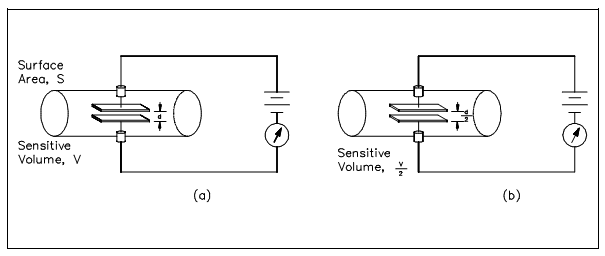Minimizing Gamma Influence:
Discrimination is possible since the ionizations generates through the alpha particles differ in energy stages from those generates through gamma rays. A 1 MeV alpha particle moving by the gas loses all of its energy in a few centimeters. Thus, all of the secondary electrons are generates along a path of only a few centimeters. A 1 MeV gamma ray generates a 1 MeV electron, and this electron has a long range and loses its energy over the whole length of its range. The sensitivity to gamma rays is reduced if we make the sensitive volume of the chamber smaller without decreasing the area of the coated boron.
Above figure illustrates how the chamber might be modified to complete this reduction.

Figure: Minimizing Gamma Influence by Size and Volume
In given Figure there is half as much gas in the sensitive volume as in the chamber in Figure. As a conclusion, gamma rays have only half as much gas to interact along with; thus, half the number of electrons is generates. The area that is boron-coated has not changed, and both chambers produce the similar number of neutron-induced alpha particles. Also, the gamma ray- induced electrons generates less ionization since the range of these electrons is longer than the dimensions of the sensitive volume. A range of neutron-induced alpha particles is short and all of the energy will be dissipated inside the sensitive volume, even while the volume is smaller.
Gamma interference can also be minimized through reducing the pressure of the gas within the chamber. The reduction in pressure decreases the number of atoms inside the sensitive volume and has the similar effect as reducing the volume.